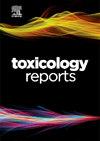富多酚正丁醇部位对四氯化碳诱导大鼠肝纤维化的保护作用:体内研究。
Q1 Environmental Science
引用次数: 0
摘要
肝纤维化是对各种化学、病毒和病理性疾病引起的慢性损伤的持续伤口愈合反应;目前还没有批准的药物或方法来逆转或预防肝纤维化,这使得它成为一个有趣的研究领域。本研究探讨了芫花酚提取物对大鼠肝纤维化模型的潜在保护作用。连续6周腹腔注射四氯化碳(CCl4)诱导肝纤维化;山茱萸和水飞蓟素丁醇部分与CCl4同时口服。六周后,所有动物都被安乐死。采用ELISA法测定大鼠肝组织丙二醛(MDA)和谷胱甘肽(GSH)水平,测定血清肝酶和蛋白水平。观察肝组织转化生长因子(TGF-β1)、α-平滑肌肌动蛋白(α-SMA)、羟脯氨酸的组织病理学和免疫组化水平。高效液相色谱法检测出槲皮素、没食子酸、芦丁、山奈酚、水飞蓟宾、芹菜素等主要成分。与诱导治疗相比,丁醇提取物治疗可降低血清ALT、AST、胆红素和白蛋白水平。此外,与诱导相比,蛇麻草提取物增加了肝脏GSH水平,降低了肝脏MDA水平。大鼠肝组织TGF-β1、α-SMA和羟脯氨酸表达下调。与诱导组相比,肝组织病理学显示其特征有所改善。综上所述,口服富多酚正丁醇部位对CCl4所致肝纤维化具有保护作用,可能通过抗氧化和抗炎机制实现。本文章由计算机程序翻译,如有差异,请以英文原文为准。
The hepatoprotective effects of the polyphenol-enriched n-butanol fraction of Cnicus benedictus against carbon tetrachloride-induced liver fibrosis in rats: In vivo study
Liver fibrosis is a continuous wound-healing response to chronic injury caused by various chemical, virus, and pathological disorders; the lack of approved drugs or methods to reverse or prevent liver fibrosis makes it an interesting area of research. This study investigates the potential hepatoprotective effects of the phenolic extract of Cnicus benedictus in rat’s module of liver fibrosis. Liver fibrosis was induced by intraperitoneal injection of carbon tetrachloride (CCl4) for six consecutive weeks; the butanol fraction of Cnicus and silymarin was administered orally concurrently with CCl4. After six weeks, all animals were euthanized. Rat liver tissue levels of malondialdehyde (MDA) and glutathione (GSH) were measured, and serum liver enzymes and protein were measured using the ELISA technique. Histopathological study and immunohistochemistry of liver tissue for transforming growth factor (TGF-β1), alpha-smooth muscle actin (α-SMA), and hydroxyproline were assessed. In HPLC analysis, Cnicus extract showed several components, including quercetin, gallic acid, rutin, kaempferol, silibinin, and apigenin. Treatment with Cnicus butanol extract reduces serum ALT, AST, bilirubin, and albumin levels compared to induction. Additionally, Cnicus extract increases liver GSH levels and decreases liver MDA levels compared to induction. Liver tissue of TGF-β1, α-SMA, and hydroxyproline expression was downregulated in rats receiving Cnicus extract. Liver tissue histopathology showed improvement in its features compared to the induction group. In conclusion, oral administration of the polyphenol-enriched n-butanol fraction of Cnicus benedictus showed a protective effect on liver fibrosis caused by CCl4, possibly through antioxidant and anti-inflammatory mechanisms.
求助全文
通过发布文献求助,成功后即可免费获取论文全文。
去求助
来源期刊

Toxicology Reports
Environmental Science-Health, Toxicology and Mutagenesis
CiteScore
7.60
自引率
0.00%
发文量
228
审稿时长
11 weeks
 求助内容:
求助内容: 应助结果提醒方式:
应助结果提醒方式:


